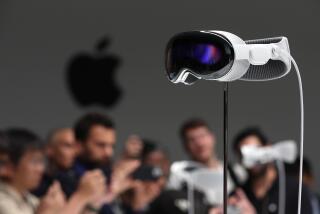iAmericans
THE MANIA surrounding Apple’s iPhone, which goes on sale today, is more than a testament to the company’s prodigious marketing abilities. Chief Executive Steve Jobs’ vaunted “reality distortion field” may have created an aura around the device, but it isn’t powerful enough to sustain nearly six months of fever-pitch anticipation all by itself.
Instead, the intense interest in the iPhone reveals something about Americans beyond their weakness for electronic status symbols. It’s a coming-of-age moment for computers and the Internet, which have become so deeply integrated into people’s daily lives that even those who don’t want to tote a laptop or be tethered to their jobs still want access to the Web wherever they go.
For proof, consider what truly distinguishes Apple’s latest creation from yesterday’s novel “smartphones” and music-playing hybrids: It’s a full-blown computer that promises an online experience much like what a laptop can deliver. It’s not limited to websites that have been slimmed down to fit onto underpowered cellphones with tiny screens. And although it doesn’t support much audio or video online, it can deliver a host of “Web 2.0” services — generating maps, checking prices, collecting news, perusing blogs, sharing photos, banking online; the list goes on and on.
Ten years ago, the ability to do such things wherever you happened to be would have seemed like a pointless luxury. But one of the transforming effects of a high-speed Internet connection, which nearly three-fourths of home Internet users have, is that it spurs people to replace physical resources with virtual ones. Why keep a phone book? Why bother with paper maps, newspaper classifieds, calculators or TV Guide? And the more people make that switch, the more compelling a device like the iPhone becomes.
The iPhone’s shortcomings, including its reliance on AT&T’s relatively weak mobile-phone network, mean that it’s not likely to fulfill all the fantasies its marketing has inspired. And even if Apple succeeds in selling 10 million of the devices by the end of next year, that will account for only a fraction of the industry’s sales. Still, the iPhone’s shiny black surface is like a mirror, and it reflects a public that can’t bear to log off.
More to Read
A cure for the common opinion
Get thought-provoking perspectives with our weekly newsletter.
You may occasionally receive promotional content from the Los Angeles Times.










